While other producers lay claim to be first in Champagne, you have to
look at what they mean by this. Champagne could only be transported in
bottle starting in May of 1728. Gosset
widely proclaims to be “first” in Champagne, but what they mean by this is that
they have been making non-sparkling wines in Champagne since 1584. There are
others who lay claim to being “first” in Champagne because their family lived in
Champagne first, they walked their dog across Champagne first, or they had a
dream about sparkling wine before anyone else. I point this out so that you
understand why you may see numerous claims of “first in Champagne.”
While the father and son duo of Nicolas and Nicolas
Ruinart (yes, they had the same name) established the house, their
inspiration came from brother and uncle Dom Thierry
Ruinart who was a Benedictine monk and a close friend of
Dom Perignon. Before making Champagne, the
Ruinart family traded in cloth, but Dom Thierry saw a rising interest in
Champagne and encouraged the family to take up the practice of Champagne. The
son of the Nicolas Ruinart combo eagerly took on this challenge and kicked off
the Champagne business by using it as a giveaway to customers of the Ruinart
cloth business. However, just like Topps made baseball cards as a giveaway to
entice people to buy their gum only to see baseball cards become the main
product, Ruinart quickly realized that there was more potential in the
“giveaway” Champagne than in cloth itself. By 1735, Champagne was the main
business.
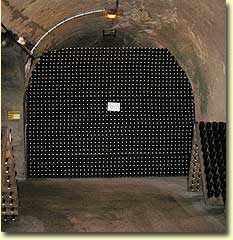 While Ruinart has been around for a long time and have always been one of the
Grand Marques, they are one of the smaller “big” houses. Until 1950, they were
producing only around 250,000 bottles a year. Then
Baron Philippe de Rothschild invested in them and production
increased to close to 1,000,000 bottles a year by 1963 when
Moet and Chandon (now LVMH) purchased them.
Many would say that LVMH would try to increase production “out the whazoo,” but
production has remained steady at around 2,000,000 bottles for a number or years
and is not likely to increase anytime soon. This means that among the big
houses, they make a little more than Bollinger,
but a little less than Louis Roederer… and
more Dom Perignon is made than all the Ruinart cuvees combined.
While Ruinart has been around for a long time and have always been one of the
Grand Marques, they are one of the smaller “big” houses. Until 1950, they were
producing only around 250,000 bottles a year. Then
Baron Philippe de Rothschild invested in them and production
increased to close to 1,000,000 bottles a year by 1963 when
Moet and Chandon (now LVMH) purchased them.
Many would say that LVMH would try to increase production “out the whazoo,” but
production has remained steady at around 2,000,000 bottles for a number or years
and is not likely to increase anytime soon. This means that among the big
houses, they make a little more than Bollinger,
but a little less than Louis Roederer… and
more Dom Perignon is made than all the Ruinart cuvees combined.
Ruinart supplies around 20% of their own grape needs with the Grand Cru
vineyards in Sillery leading the way. In what I would consider a refreshing
viewpoint, Ruinart explains why they buy in grapes with the following - Why
would we not buy in grapes from growers who turn out wonderful fruit? If it is
good why does it matter if you grow it or someone else does; the key is a close
relationship with the grower and respect for where the grapes come from.
When it comes to the top end Dom Ruinart cuvees (named after the previously
mentioned monk and first made in 1959 for the Blanc de Blancs and 1962 for the
Rose), most of the grapes come from Avize, Cramant, Chouilly, & Le
Mesnil-sur-Oger in the Cote de Blancs and, Sillery, Verzy, & Verzenay in the
Montange de Reims. What is most interesting about the Blanc de Blancs is that a
good portion of the Chardonnay grapes come from the Montange de Reims. This
makes for an interesting character in the wine as the Cote de Blancs is better
known for Chardonnay and the Montange de Reims for Pinot Noir. It also means
that the Dom Ruinart Blanc de Blancs doesn’t follow the normal rules for classic
Chardonnay. In vintages where the Montagne de Reims Pinot Noir excels, you will
often find the Dom Ruinart Blanc de Blancs does as well. The Montange de Reims
terroir also seems to give the Chardonnay a bit more body than what is seen in
the Cote de Blancs.
As I mentioned, Frédéric Panaïotis is the Chef de Caves at Ruinart. He took over
these duties earlier this year (2007) following in the footsteps of
Jean Philippe Moulin (his predecessor) and
Jean-Francois Barot (Jean Philippe’s
predecessor). Before taking the reigns at Ruinart, Frédéric assisted
Jacques Peters in the winemaking at
Veuve Clicquot and did a number of research
studies with the CVIC on Champagne closures and Champagne storage. Frédéric is
part of the young and upcoming wave of winemakers in Champagne who not only has
a passion for Champagne, but understands the dynamic between growers and houses
and has a love for wine in general. His personality shines through when you talk
to him and you cannot help but be caught up in his excitement over wine.
I feel I should also mention my overall impression of the Ruinart style. The
Blanc de Blancs is characterized by creamy citrus and minerals that turn into
vanilla laced toast over time. The Rose is characterized by dry cherry skins,
forest leaves, fall spices, gentle tobacco notes, and a subtle acidic streak
that holds everything together. To me, these are wines meant for Burgundy
lovers. I love all of the wines of Ruinart, but to me the Rose is the star of
the house. Along with Moet’s Dom Perignon Rose and Taittinger’s Comtes de
Champagne Rose, I feel that Ruinart’s Dom Ruinart Rose is one of the top three
Rose Champagnes on the market (I will also mention that there are quite a few
others nipping at the heels of these three).
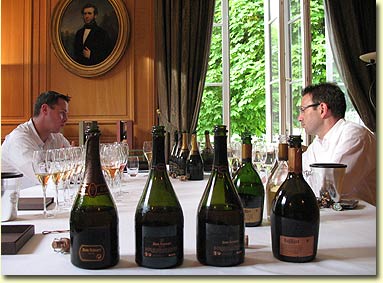 Most of the wines below were tasted multiple times over a six month period. A
majority of them were tasted with Frédéric Panaïotis at Ruinart
(right) in Reims, France
in June, 2007 and at
NoMI
(below right) in Chicago in October, 2007 (a wonderful dinner
organized by Frédéric and Ruinart’s Central US Manager
Sarah Votaw). A few of the bottles below were also tasted on other
occasions. The bottle format was normally 750 mL, but some Magnums were also
tasted. While the magnums were clearly aging slower than the 750s, the profile
of the wines was the same in both sizes. I would say that the Magnums scored at
the high end of the scoring range given
Most of the wines below were tasted multiple times over a six month period. A
majority of them were tasted with Frédéric Panaïotis at Ruinart
(right) in Reims, France
in June, 2007 and at
NoMI
(below right) in Chicago in October, 2007 (a wonderful dinner
organized by Frédéric and Ruinart’s Central US Manager
Sarah Votaw). A few of the bottles below were also tasted on other
occasions. The bottle format was normally 750 mL, but some Magnums were also
tasted. While the magnums were clearly aging slower than the 750s, the profile
of the wines was the same in both sizes. I would say that the Magnums scored at
the high end of the scoring range given
 for each wine, but this is to be
expected. A similar trend was seen in regard to the sourcing of the bottles
(some came straight from the Ruinart cellars, some were stored in the Ruinart
offices, some were purchased from shops in Europe, and some were purchased here
in the US). Even with bottle size, sourcing, and storage differences, each cuvee
was consistent and settled nicely into a range. It is this slight (and normal)
variation between bottles of the same wine that lead me to score in a range (A-,
90-92 pts) rather than as an individual point score (92 pts.
for each wine, but this is to be
expected. A similar trend was seen in regard to the sourcing of the bottles
(some came straight from the Ruinart cellars, some were stored in the Ruinart
offices, some were purchased from shops in Europe, and some were purchased here
in the US). Even with bottle size, sourcing, and storage differences, each cuvee
was consistent and settled nicely into a range. It is this slight (and normal)
variation between bottles of the same wine that lead me to score in a range (A-,
90-92 pts) rather than as an individual point score (92 pts.
When I am tasting, I give each bottle a letter grade with a point range to try
and convey what you can really expect. While a specific bottling can be
consistent, some variation is going to occur. When I say a wine is an “A-,“ this
variation is captured as most of the bottles will be in the 90-92 pt range. An
occasional outlier may stretch this out by coming in at 89 or 93 pts, but the
overall quality of the wine is conveyed. I have a hard time understanding single
point scores as I can open multiple bottles of a wine from the same case and
sometimes score each one slightly different even though they all have a similar
level of quality. Most people would probably agree with this and while you can
make a case that a single point score is the average or expected performance of
a bottle, I have never seen anyone explain it that way. I’m sure there are
people who laugh at me for trying to grade wines in ranges and I understand that
(even if I disagree with them), but giving out a single point score just doesn’t
make sense to me as it implies that variation does not exist.
End of rant and on to the wines except for one final point. I mentioned earlier
that the Dom Ruinart cuvees have new clothes. The prestige cuvee Dom Ruinart is
now housed in a redesigned bottle and box that are very classy and worthy of two
of the best Champagnes on the market. A small ribbon is used to tear off the
capsule cover on the bottle and the box is quite artistic with two flaps that
open covered by a metal Dom Ruinart logo. It is a presentation worthy of such a
fine wine.
NV R de Ruinart Brut
(40% Chardonnay, 60% Pinot Noir; 2003 Based; 10 g/L dosage; Disgorged 2007;
$45-60 US)
Very fruity and forward with flowers and cream on the nose and ripe pears and
citrus on the palate. The 2003 character is showing through in this wine, but
reserve wines keep it restrained and balance the cuvee out. I’ve always enjoyed
the NV - especially with 3-5 years of bottle age. A very nice effort.
Grade of B (83-86 pts). Find this wine
NV Blanc de Blancs
(100% Chardonnay; 2003 Based; Disgorged 2007;
$50-65 US)
Very alive and fragrant on the nose and palate. Loads of slightly sweet citrus,
some tartness, creamy gobs of minerality, and peach blossoms make this a
spectacular NV wine. I have yet to meet someone who doesn’t like this wine.
Grade of High B+ (88-90 pts). Find this wine
NV Rose
(45% Chardonnay, 55% Pinot Noir; 18% Pinot Noir
still wine added; Disgorged 2007; $60-75 US)
This is full of strawberries and cherry skins with creamy minerals. It has a
perfect balance of sweet, dry, and richness. Where the Dom Ruinart Roses are
made to be cellared and contemplated, this wine is meant to popped, poured, and
enjoyed. Grade of High B+ (88-90 pts). Find this wine
 1964 Ruinart Reserve Baron Philippe de Rothschild
1964 Ruinart Reserve Baron Philippe de Rothschild
(Believed to be 50% Chardonnay, 50% Pinot Noir;
Disgorged early 1970s; $250-350 US)
While this wine has definitely gone over to the side of full maturity, I found
it very enjoyable. The nose showed nutty, spicy, and was slightly sherried with
whispers of mocha cream. While the palate also showed some nutty sherry, it also
had a nice dose of acidity to give it a bit of spunk. Frédéric called out ginger
as the main flavor of this wine and I think he nailed it. Towards the back of
the palate some chocolate and coffee come out. A wonderful glimpse at a wine
from yesterday. Grade of Low B+(86-88 pts). Find this wine
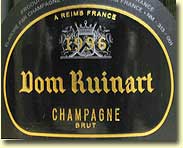 1996 Dom Ruinart Blanc de Blancs
1996 Dom Ruinart Blanc de Blancs
(100% Chardonnay; All Grand Cru; 60% Cote de
Blancs, 40% Montagne de Reims; Disgorged 2006; 7 g/L dosage; $130-190 US)
Very young right now and not giving anywhere near what it eventually will. For
today it shows a very gentle palate dominated by lemon flavored minerality, and
some doses of cream. Where it begins to show its potential is on the finish
where a creamy, mouthwatering citrus component gives you a glimpse of what is to
come. Grade of B+ (87-89 pts) for today with High A-
potential (91-93 pts). Find this wine
1993 Dom Ruinart Blanc de Blancs
(100% Chardonnay; All Grand Cru; 65% Cote de
Blancs, 35% Montagne de Reims; Disgorged 2001-2003; 7 g/L dosage; $125-150 US)
The odd thing with this wine is that every bottle I have had shows a
strange funk on the nose that eventually blows off, but leaves me wondering
where it comes from. Loads of concentrated citrus, minerality, and buttery
oranges highlight this “ready to go” vintage. To me, this is at or already near
its peak and is perfect to open right now. Grade of
High B+ (88-90 pts). Find this wine
1990 Dom Ruinart Blanc de Blancs
(100% Chardonnay; All Grand Cru; 50% Cote de
Blancs – all Cramant – and 50% Montagne de Reims; Disgorged 1999-2000; 8 g/L
dosage; $110-200 US)
This wine is always good and can sometimes reach amazing heights. An oxymoron of
a nose shows maturity and youth at the same time as light toast, peach, honey,
and citrus form a pleasure parade that continues marching into your mouth.
Flavors of peach laced minerals, caramel, butterscotch, and toast branch off of
a citrus backbone to keep the parade going before it leaves with a long, lively,
creamy citrus finish. This wine probably has more room to grow, but it is sure
good right now. In fact, it is a candidate for wine of the vintage.
Grade of A (93-96 pts). Find this wine
1988 Dom Ruinart Blanc de Blancs
(100% Chardonnay; All Grand Cru; 54% Cote de
Blancs, 46% Montagne de Reims; Disgorged late 1990s; 8 g/L dosage; $125-200 US)
This vintage is maturing a bit faster than I would have expected as it showing a lot of
toast, caramel, and vanilla peach. The wine still does have a good
citrus component, but there is a salinity that is starting to come out and to me
this signals that the wine is more than likely moving out of its youthful
development and starting to enter maturity. I think most would enjoy over the
next few years unless you are a lover of mature Champagne.
Grade of Low A- (89-90 pts). Find this wine
1985 Dom Ruinart Blanc de Blancs
(100% Chardonnay; All Grand Cru; 75% Cote de
Blancs, 25% Montagne de Reims; Disgorged mid 1990s; 8 g/L dosage; $160-220 US)
Quite mature compared to other 1985 Champagnes, but I enjoy the mature flavors
it is showing. Sherry and citrus dominate the nose while plenty of caramel,
cream, butter, toffee join citrus, apricot, and peach on the palate. While I
enjoyed the maturity of this wine, I can understand others not liking it as much
especially as it is at the somewhat awkward stage of being rather mature, but
also still showing some fresh acidity in the background. To those who don’t
enjoy this stage in the Champagne metamorphosis, I would advise that you let
this rest for another 5-10 years as it will smooth out and become fully mature
with subtle acidity. Grade of B+ (87-89). Find this wine
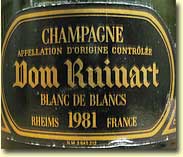 1981 Dom Ruinart Blanc de Blancs
1981 Dom Ruinart Blanc de Blancs
(100% Chardonnay; All Grand Cru; Mix of Cote de
Blancs and Montagne de Reims; Disgorged ~ 1990; $175-250 US)
Toast, citrus, minerals, and cream make up the nose on this and you would never guess
it's from 1981, as it seems to still be holding back a bit. The palate
clarifies by showing you that it isn’t holding back, it just
doesn’t have the oomph or expression of some of the other vintages. Still the
notes of cream, butter, citrus, peach stained minerals, and well done buttered
toast make for a nice wine that will hold, but is also ready to drink now.
Grade of Low B+ (86-88 pts). Find this wine
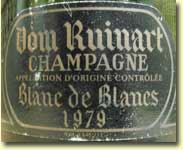 1979 Dom Ruinart Blanc de Blancs
1979 Dom Ruinart Blanc de Blancs
(100% Chardonnay; All Grand Cru; Mix of Cote de
Blancs and Montagne de Reims; Disgorged late 1980s; 10 g/L dosage; $200-300 US)
This wine defies its age as the acidity is still strong and sharp. Loads of
fruit and touches of toast and white chocolate make this wine hard to put down
and the long finish with kisses of peach, orange, and apricot make you ask for a
refill. A wonderful wine. Grade of A (93-96 pts). Find this wine
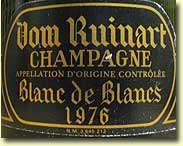 1976 Dom Ruinart Blanc de Blancs
1976 Dom Ruinart Blanc de Blancs
(100% Chardonnay; All Grand Cru; Mix of Cote de
Blancs and Montagne de Reims; Disgorged mid 1980s; 8 g/L dosage; $250-350 US)
This wine is a big, wonderful, exciting serving of fruit salad on the nose and
on the initial palate, but it then loses its way a bit as it doesn’t seem to
have as much stuffing as the nose leads on. There are some caramel and spiced
citrus notes to the wine, but it just seems a bit one dimensional and a touch
overdone or flabby. Something is missing in the wine after the initial flavors.
It is still alive and a pleasure to drink, but leaves me wondering what could
have been if only the wine hadn’t faded on the mid palate and finish.
Grade of B+ (87-89 pts). Find this wine
1996 Dom Ruinart Rose
(83% Chardonnay, 17% Pinot Noir from red wine
addition; All Grand Cru; Pinot Noir is mostly Verzy and Verzenay; Disgorged
2006; 7-8 g/L dosage; $225-$300 US)
A wonderful wine that is enjoyable now, but far to young to drink in good
conscience. Cherry blossoms and hints of autumn leaves dance on your nose while
dry red berries, cherry skins and citrus leaves your palate tingling with a red
spritzer finish. Some cream and minerality also come out and play making this
wine all the more seductive. Grade of A- for today
(90-92 pts) with A potential (93-96 pts). Find this wine
1990 Dom Ruinart Rose
(82% Chardonnay, 18% Pinot Noir from red wine
addition; All Grand Cru; Pinot Noir is mostly Verzy and Verzenay; Disgorged ~
2000; 8 g/L dosage; $175-$250 US)
As much as I loved all of the wines, this wine stole the show in both 750 mL and
magnum format. Full of amazing acidity on the entrance, this opens up into a
spicy concoction of pastry wrapped around cherry vanilla and orange marmalade
filling. On the tail end of the palate and finish, some tobacco and forest floor
also seem to sneak in. This is already stunning and is still quite young
(especially out of magnum). It is almost scary to think how good this could get.
A masterpiece that is not only a candidate for the wine of the vintage in 1990,
but it would measure up with the frontrunners in almost any vintage.
Grade of Strong A (94-96 pts) with the possibility of
improving a bit. Find this wine
1986 Dom Ruinart Rose
(80-85% Chardonnay, 15-20% Pinot Noir from red
wine addition; All Grand Cru; Pinot Noir is mostly Verzy and Verzenay; Disgorged
mid 1990s; $225-$300 US)
Another very lively Rose with a richness and coffee character that only time can
bring. This is quite Burgundian with spice box and dark cherry flavors. While
this may not be as good as the 1990, I really enjoy it for current drinking.
Grade of High A- (91-93 pts). Find this wine
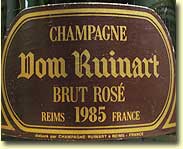 1985 Dom Ruinart Rose
1985 Dom Ruinart Rose
(85% Chardonnay, 15% Pinot Noir from red wine
addition; All Grand Cru; Pinot Noir is mostly Verzy and Verzenay; Disgorged mid
1990s; 8 g/L dosage; $250-$300 US)
This wine is a little tough to figure out as it also seems to be in the midst of
a change. It opens up with some mature flavors of red sherry, forest floor, and
chocolate, but then quickly morphs into a young red citrus, cherry skin
concoction that still has some tannic bite on the finish. With time in the glass
it seemed to close up rather than bloom. For right now,
this gets a Grade of B+ (87-89 pts), but if it wakes up and comes back to life,
it should easily rise up to the A- level (90-92 pts).
Find this wine
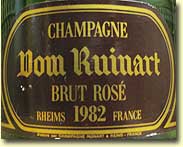 1982 Dom Ruinart Rose
1982 Dom Ruinart Rose
(80-85% Chardonnay, 15-20% Pinot Noir from red
wine addition; All Grand Cru; Pinot Noir is mostly Verzy and Verzenay; Disgorged
early 1990s; 8 g/L dosage; $300-$350 US)
A truly seductive wine with gentle fall spice flavors and an aged cherry
dominated red berry basket. The acidity and sweetness balance is wonderful. To
me, drinking this wine is like relaxing in your favorite chair and smoking a
cigar – meaning it is warm, inviting, comfortable, and familiar. I see no reason
to wait on this. It is in its full glory now. Grade of
High A- (91-93 pts).
Find this wine
1981 Dom Ruinart Rose
(85% Chardonnay, 15% Pinot Noir from red wine
addition; All Grand Cru; Pinot Noir is mostly Verzy and Verzenay; Disgorged
early 1990s; 12 g/L dosage; $300-$350 US)
A wonderful wine with a clear sweetness that has integrated nicely with the red
berry, cherry, and autumn leaf aromas and flavors. Over time, the acidity comes
out more and more showing that this isn’t done growing yet.
Grade of A- (90-92 pts).
Find this wine
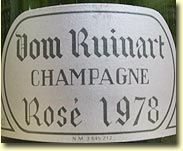 1978 Dom Ruinart Rose
1978 Dom Ruinart Rose
(80-85% Chardonnay, 15-20% Pinot Noir from red
wine addition; All Grand Cru; Pinot Noir is mostly Verzy and Verzenay; Disgorged
late 1980s; $300-$375 US)
Initially this was very tight with lots of dry red berry skins, autumn leaves,
and young citrus, but over time, it seemed to fall apart a
bit rather than open up, as the flavors became a bit bland. For this reason, I would recommend
drinking up now. Grade of B+ (87-89) for the initial
impression, but within an hour this was no longer drinking at this level. Find this wine
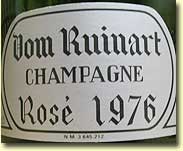 1976 Dom Ruinart Rose – Recently Disgorged
1976 Dom Ruinart Rose – Recently Disgorged
(80-85% Chardonnay, 15-20% Pinot Noir from red wine
addition; All Grand Cru; Pinot Noir is mostly Verzy and Verzenay; Disgorged
September 2007; 4 g/L dosage; $400-$500 US)
Along with the two 1990s and the 1979 Blanc de Blancs, this was a step above
everything else on the night. It was amazing in how young it seemed with red
citrus still prevalent throughout and tannins still gently biting down on the
finish. The cinnamon sprinkled baked cherry pie aromas and flavors didn’t hurt
things either. This is very, very good. Grade of A
(93-95 pts).
Find this wine
Cheers!
Brad Baker
Philipponnat |
Veuve Clicquot | Vilmart |
Jacquesson | Ruinart |
Goutorbe Part 1
Goutorbe Part 2 |
Henri Giraud | Chartogne-Taillet | Introduction
BACK TO THE TOP
BACK TO BRAD BAKER'S
INDEX PAGE
November 2007 © Brad Baker


 Over the past year, I have been lucky
enough to have numerous occasions to taste the wines of
Over the past year, I have been lucky
enough to have numerous occasions to taste the wines of
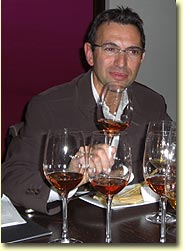 Once we made it to house and parked, we started our visit with a tour of the
caves. Chef de Caves (cellarmaster/headwinemaker)
Frédéric Panaïotis (left) insisted I visit the caves and I was happy enough
to do so, but wasn’t sure whether to take him seriously or not when he told me
that the Ruinart caves were different. After all, I enjoy walking the
caves/cellars of every producer and looking at the old bottles, but the cellars
do all start to look the same after a while. Well, Ruinart doesn’t look the
same. In fact, if you are only going to visit the caves of one Champagne
producer, I would recommend Ruinart. No other house has caves anywhere near as
interesting or beautiful.
Once we made it to house and parked, we started our visit with a tour of the
caves. Chef de Caves (cellarmaster/headwinemaker)
Frédéric Panaïotis (left) insisted I visit the caves and I was happy enough
to do so, but wasn’t sure whether to take him seriously or not when he told me
that the Ruinart caves were different. After all, I enjoy walking the
caves/cellars of every producer and looking at the old bottles, but the cellars
do all start to look the same after a while. Well, Ruinart doesn’t look the
same. In fact, if you are only going to visit the caves of one Champagne
producer, I would recommend Ruinart. No other house has caves anywhere near as
interesting or beautiful. The chalk caves (called crayères meaning chalk pits or mines) at Ruinart are
absolutely spectacular with a depth of almost 100 feet and miles of caves. The
house was built on top of a chalk mine for the specific reason of storing wines.
The chalk walls provide not only a stunning pearl white backdrop, but more
importantly, they provide excellent humidity. In addition to this, the depth
underground provides a constant temperature of around 50 deg F for the wines to
slowly age. The crayères also made for a hiding place during the World Wars as
many Champenois carried out their lives underground during this time. One of the
most famous stories about this occurred during the Battle of Marne in World War
I. As Reims came under attack, house head Andre Ruinart
relocated business activities to the cellars. As the attacks continued and the
caves were flooded to try to drive the people out, he built himself a raft and
continued to do business. It should also be noted that this wasn’t just for an
hour or so as having to do things like this was common during the War. During
the World Wars, much of Champagne operated underground for extended periods of
time.
The chalk caves (called crayères meaning chalk pits or mines) at Ruinart are
absolutely spectacular with a depth of almost 100 feet and miles of caves. The
house was built on top of a chalk mine for the specific reason of storing wines.
The chalk walls provide not only a stunning pearl white backdrop, but more
importantly, they provide excellent humidity. In addition to this, the depth
underground provides a constant temperature of around 50 deg F for the wines to
slowly age. The crayères also made for a hiding place during the World Wars as
many Champenois carried out their lives underground during this time. One of the
most famous stories about this occurred during the Battle of Marne in World War
I. As Reims came under attack, house head Andre Ruinart
relocated business activities to the cellars. As the attacks continued and the
caves were flooded to try to drive the people out, he built himself a raft and
continued to do business. It should also be noted that this wasn’t just for an
hour or so as having to do things like this was common during the War. During
the World Wars, much of Champagne operated underground for extended periods of
time. While Ruinart has been around for a long time and have always been one of the
Grand Marques, they are one of the smaller “big” houses. Until 1950, they were
producing only around 250,000 bottles a year. Then
Baron Philippe de Rothschild invested in them and production
increased to close to 1,000,000 bottles a year by 1963 when
Moet and Chandon (now LVMH) purchased them.
Many would say that LVMH would try to increase production “out the whazoo,” but
production has remained steady at around 2,000,000 bottles for a number or years
and is not likely to increase anytime soon. This means that among the big
houses, they make a little more than Bollinger,
but a little less than Louis Roederer… and
more Dom Perignon is made than all the Ruinart cuvees combined.
While Ruinart has been around for a long time and have always been one of the
Grand Marques, they are one of the smaller “big” houses. Until 1950, they were
producing only around 250,000 bottles a year. Then
Baron Philippe de Rothschild invested in them and production
increased to close to 1,000,000 bottles a year by 1963 when
Moet and Chandon (now LVMH) purchased them.
Many would say that LVMH would try to increase production “out the whazoo,” but
production has remained steady at around 2,000,000 bottles for a number or years
and is not likely to increase anytime soon. This means that among the big
houses, they make a little more than Bollinger,
but a little less than Louis Roederer… and
more Dom Perignon is made than all the Ruinart cuvees combined. Most of the wines below were tasted multiple times over a six month period. A
majority of them were tasted with Frédéric Panaïotis at Ruinart
(right) in Reims, France
in June, 2007 and at
Most of the wines below were tasted multiple times over a six month period. A
majority of them were tasted with Frédéric Panaïotis at Ruinart
(right) in Reims, France
in June, 2007 and at
 for each wine, but this is to be
expected. A similar trend was seen in regard to the sourcing of the bottles
(some came straight from the Ruinart cellars, some were stored in the Ruinart
offices, some were purchased from shops in Europe, and some were purchased here
in the US). Even with bottle size, sourcing, and storage differences, each cuvee
was consistent and settled nicely into a range. It is this slight (and normal)
variation between bottles of the same wine that lead me to score in a range (A-,
90-92 pts) rather than as an individual point score (92 pts.
for each wine, but this is to be
expected. A similar trend was seen in regard to the sourcing of the bottles
(some came straight from the Ruinart cellars, some were stored in the Ruinart
offices, some were purchased from shops in Europe, and some were purchased here
in the US). Even with bottle size, sourcing, and storage differences, each cuvee
was consistent and settled nicely into a range. It is this slight (and normal)
variation between bottles of the same wine that lead me to score in a range (A-,
90-92 pts) rather than as an individual point score (92 pts.  1964 Ruinart Reserve Baron Philippe de Rothschild
1964 Ruinart Reserve Baron Philippe de Rothschild 1996 Dom Ruinart Blanc de Blancs
1996 Dom Ruinart Blanc de Blancs 1981 Dom Ruinart Blanc de Blancs
1981 Dom Ruinart Blanc de Blancs 1979 Dom Ruinart Blanc de Blancs
1979 Dom Ruinart Blanc de Blancs 1976 Dom Ruinart Blanc de Blancs
1976 Dom Ruinart Blanc de Blancs 1985 Dom Ruinart Rose
1985 Dom Ruinart Rose 1982 Dom Ruinart Rose
1982 Dom Ruinart Rose 1978 Dom Ruinart Rose
1978 Dom Ruinart Rose 1976 Dom Ruinart Rose – Recently Disgorged
1976 Dom Ruinart Rose – Recently Disgorged